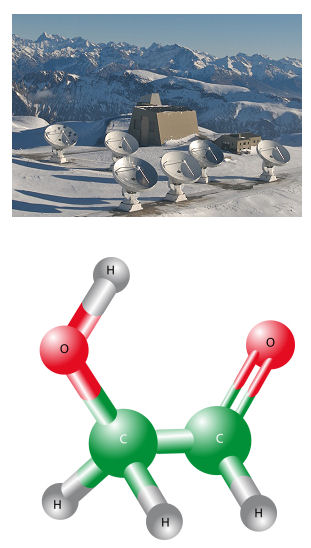26 November 2008
Organic molecule hints at alien life
by Kate Melville
 Scientists have detected glycolaldehyde (an organic sugar molecule that is directly linked to the origin of life) 26,000 light years from Earth in a region of our galaxy where habitable planets may exist. The international team of astronomers used the IRAM radio telescope in France (pictured) to detect the molecule and they have reported their findings in Astrophysical Journal Letters.
Scientists have detected glycolaldehyde (an organic sugar molecule that is directly linked to the origin of life) 26,000 light years from Earth in a region of our galaxy where habitable planets may exist. The international team of astronomers used the IRAM radio telescope in France (pictured) to detect the molecule and they have reported their findings in Astrophysical Journal Letters.
Glycolaldehyde, the simplest of the monosaccharide sugars, can react with the substance propenal to form ribose, a central constituent of ribonucleic acid (RNA). Glycolaldehyde has previously only been detected towards the centre of our galaxy where conditions are extreme compared to the rest of the galaxy. This new discovery, in an area far from the galactic center, also suggests that the production of this key ingredient for life could be common throughout the galaxy. This is encouraging news in our search for alien life as a wide spread of the molecule improves the chances of it existing along side other molecules vital to life.
The team was able to detect glycolaldehyde by using the telescope to observe the region with high-angular resolution and at different wavelengths. The observations confirmed the presence of three lines of glycolaldehyde towards the most central part of the core of the region.
"This is an important discovery as it is the first time glycolaldehyde, a basic sugar, has been detected towards a star-forming region where planets that could potentially harbor life may exist," said Dr Serena Viti, one of the paper's authors from University College London.
Related:
DNA Precursors In Meteorite Confirmed As Extraterrestrial
ETs Very Unlikely, New Calculations Suggest
Meteorites Spiced Up Primordial Soup
"Hot" Comets The Source Of Life?
Source: Astrophysical Journal Letters
